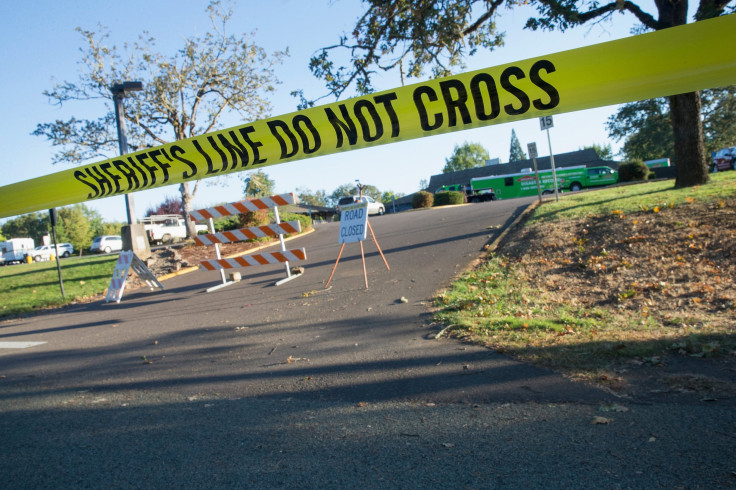After Oregon Shooting, Should Online School Threats Be Taken More Seriously?

Chris Harper-Mercer may have warned someone before initiating last week's massacre at Umpqua Community College. Soon after the suspect killed nine people and himself in Roseburg, Oregon, an anonymous post on a 4chan message board began circulating online. It told readers, "Don't go to school tomorrow if you are in the Northwest."
Authorities this week were still investigating whether Harper-Mercer was linked to the post or if it had anything to do with Thursday's Umpqua shooting. But if it did, it wouldn't be the first such scenario. As the United States moves forward in an age where young people post everything on the Internet, school threats are no exception. Psychology experts say suspects may publish their plans on social media for a variety of reasons -- mostly to get attention or feel powerful -- but the true issue is assessing how serious they are. Specificity and context are two major factors in determining whether a tweet like, "I wish my school would blow up," points to a whiny teen or a potential gunman, school security consultants said.
"We know that the majority of high school and college students are communicating on social media, and we also know that a lot of people who are in some type of distress, either expressing intentions for violent acts or reaching out for help, do that on social media," said Steven Healy, a managing partner at Margolis Healy, a campus security firm based in Burlington, Vermont. "Clearly, we need to be attuned to that conversation."
Calling in bomb threats by phone is quickly becoming a thing of the past. Of 812 school threats between August and December 2014, 299 -- or 37 percent -- were sent electronically, according to a study by the Cleveland-based consulting firm National School Safety and Security Services. That included text messages, emails, tweets, Facebook posts and Yik Yak posts. Threats to schools overall increased by 158 percent from the year before.
Though making blanket statements about school shooters as a demographic is unwise, many young people may post or reference their plans online to feel powerful, said Dr. Peter Langman, a psychologist from Allentown, Pennsylvania, and author of "Why Kids Kill: Inside the Minds of School Shooters." They also could simply be "narcissistic and arrogant," he said. "They believe that they can put it online and do it anyway, and nobody's going to be able to stop it," Langman added.
Another factor is fame. For example, Harper-Mercer's alleged email address was connected to a blog post praising Vester Flanagan, the disgruntled former TV station employee who fatally shot two ex-colleagues live on the air in August. "I have noticed that so many people like him are all alone and unknown, yet when they spill a little blood, the whole world knows who they are," the user wrote. "A man who was known by no one, is now known by everyone."
If a young person feels lonely or insecure, Langman said, "the idea of going out in a so-called blaze of glory, as they envision it, is very attractive." Social media posts uncovered in the days after the event can extend the attention paid to them.
But is it possible to uncover those threatening posts before the event -- and prevent it? Yes, though it's an imperfect science, Healy said. It's nearly impossible to monitor all students' online activity at all times. Because of this, schools need to shift from monitoring social media to receiving alerts about ideas that cause concern, he added.
Several startups have developed software that can do this. Healy helped produce Social Sentinel, a program that uses an algorithm to scan students' public social media posts for red-flag words like "bomb" or phrases like, "I can't take it anymore." However, it's only one half of a two-part prevention strategy, as there still needs to be an administrator on the other side of the screen reading the posts and evaluating the severity, Healy said. Context makes all the difference.
A post that says something like, "I can't take it anymore. I'm putting an end to this," on a student's feed filled with tweets about how bad his or her football team of choice is could simply mean they're tired of being a fan, Healy said. On the flip side, someone who repeatedly posts comments about depression or uses violent language could have a mental illness that needs treatment.
The U.S. Supreme Court ruled in July on a related case about the nature of online threats. Anthony Elonis, a Pennsylvania divorcee, contested his conviction for threatening people with violent rap lyrics he published on Facebook. The Supreme Court overturned the conviction 8-1, saying that such content must be intended as a threat -- not simply perceived as one.
Ken Trump, president of the consulting company that studied the 2014 threats, said that overall, the more specific an online threat to a school is, the more seriously it is likely to be taken by authorities. Users whose posts mention their plans, names, dates or weapons could pose a more credible danger to a school.
Even the best computer programs could still miss certain messages that administrators need to know about, Trump said, so part of addressing the growing trend of online threats is getting the community involved. He said schools should create an environment where students and parents can confidentially submit tips about worrisome posts so officials can investigate.
"It's unreasonable and unrealistic to expect school administrators sitting in a high school or college office to take on the role of 'social media police' and somehow monitor this," Trump said. Instead, they need to "change the culture where [people] understand that their reporting may save a life," he said. "They need to at least be aware of the influence of social media."
© Copyright IBTimes 2024. All rights reserved.






















